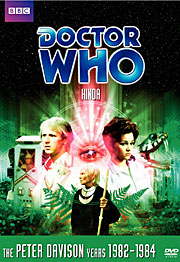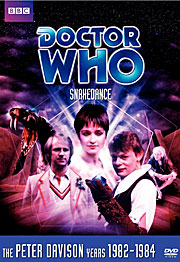Matthew Waterhouse
- Sci-Fi
- 1982
- Buy the DVD
Reviewed by Ross Ruediger
()
earch far and wide through the back catalogue of classic “Doctor Who” and you’ll be hard pressed to come up with a double bill that’s as rewarding as “Kinda” and “Snakedance.” The former is not just one of the greatest “Who” stories of the 80s, but one of the best in the entire canon of the series. The latter is… well, it’s a damn fine sequel. Both tales were penned by a guy named Christopher Bailey, who not only never wrote any other entries for the series, but after working on “Who,” never wrote for television again! This seems quite a travesty in light of how well this material has aged. Both tales are from the Peter Davison era, and both revolve heavily around the Fifth Doctor’s companion, Tegan Jovanka (Janet Fielding, who really delivers in both installments).
“Kinda” begins with the TARDIS having landed on the lush planet Deva Loka. The crew doesn’t appear to be in much of a hurry to do anything but relax, and soon enough, during a leisurely stroll through the forest, they encounter a mysterious display of enchanting chimes. Tegan, seemingly hypnotized by their spell, falls asleep beneath them while the Doctor and Adric (Matthew Waterhouse) wander off, deeper in the forest. (Sarah Sutton’s Nyssa is written out at the top of this story, and doesn’t reappear until the close.) Also on Deva Loka is an expedition from another planet – colonialists searching for a new home. Their team is quickly losing members, however, and only three remain: the militant Sanders (Richard Todd), his subordinate Hindle (Simon Rouse), and the scientist Todd (Nerys Hughes).
Standing in the way of any potential colonization are the inhabitants of Deva Loka, known as the Kinda, a telepathic tribe of mutes who may or may not be more dangerous than they appear. But the real danger lurks in the dark corners of the mind, where Tegan meets an entity known as the Mara in a bizarre, hallucinatory dream state, and it’s able to emerge into the waking world through her, and then later through one of the Kinda, giving a mute figure voice for the first time in his life. And with voice, comes power.
“Kinda” isn’t necessarily a difficult piece of sci-fi to write about, unless, of course, you’re doing it in the form of a DVD review, and one doesn’t wants to give too much away. This isn’t a scholarly text, but rather a tease to either draw you in or warn you off. In this case, it’s most definitely the former. The story is steeped in Buddhist themes, as Bailey was very much into that at the time. What I know about Buddhism can be scribbled on the back of a postage stamp, so it’s not a part of the story that I specifically connect with. What does work for me is its exploration of the mind, and its ability to show the healing power of change. The characters in “Kinda” are multi-faceted creatures, and it’s one of the few instances in the classic series where the supporting cast may even be superior to the regulars. They’re all just so incredibly well drawn, especially Hindle, who early in the tale dives over the edge into madness. Rouse gives a thrilling performance, and every time you think he’s maybe taken it a tad too far, he pulls back and makes it real again.
“Kinda” is an entirely studio-bound story, which means that a jungle had to be created from scratch. This should work against it, but it only seems to add to the dreamlike atmosphere. It’s got a wonderful score by Peter Howell, and Peter Grimwade’s direction proves exactly why he was one of the most talented men ever to work on the series. Really, I cannot recommend this story highly enough, although be warned – this isn’t typical “Doctor Who,” and for every person who loves it (and there are many), there’s someone waiting in the wings to label it total nonsense, which is too bad for them, because classic “Who” doesn’t get much more thought-provoking than this. There’s something new to see with each viewing, and as it’s all about altered states of mind, it helps to view it in an altered state. Choose your poison carefully.
A year after “Kinda,” a sequel was mounted, and as is often the case with sequels, it never quite scales the imaginative heights of the original. But that doesn’t mean “Snakedance” isn’t a fine story in its own right. Indeed, one of its strengths is that it doesn’t really try to copy the formula of the original, and instead gives the viewer a different take on the menace that is the Mara, via a far more traditional kind of “Who” story.
Tegan is having nightmares, and it seems the Mara hasn’t left her mind altogether after all. She’s unwittingly programmed the TARDIS to head for the planet Manussa, which turns out to be the home world of the Mara. But the Mara hasn’t been seen on Manussa for over 500 years. Its inhabitants have gotten lazy and stupid. They’re in the midst of preparing for a celebration of the defeat of the Mara (which they do every ten years) when the creature once again finds its way from the realm of Tegan’s mind into the real world. This time it latches onto Lon (Martin Clunes of “Men Behaving Badly,” in his first TV role ever), a descendant of the man who banished the Mara from Manussa, and the creature seeks to reclaim its position of power through the boy. Perhaps only Dojjen, a snakedancer living far out in the desert, can aid the Doctor in his quest to keep the Mara’s power at bay.
Aside from the portrayal of a society that’s so drunk on power it has no idea how to take care of itself when real danger arises, where “Snakedance” really remains a potent concoction is in its portrayal of the Doctor. Everyone sees him as a total lunatic, what with him raving on and on about the return of the Mara, which might as well be a fable as far as the Manussans are concerned. Thing is, we see people like this all the time in society, only they’re usually talking about the Second Coming or the Mayan calendar or Nostradamus or whatever, and so we write them off as crackpots. Here, the Doctor is the crackpot. He’s the nutjob going on about the end of the world and nobody will listen. Now, what this means as far as parable is concerned I’m not sure, because I know that I’m certainly not going to be taking the weirdos on the street any more seriously as a result of “Snakedance,” but isn’t it sci-fi’s job to show us these obtuse parts of our life that we so easily shut out in a different light? If so, “Snakedance” succeeds admirably.
Once again, a superb supporting cast. Clunes is wonderful, and watching him here there’s just no question that he was destined for greatness. John Carson’s Ambril is the primary skeptic toward the Doctor’s perceived lunacy, and he also knocks it out of the park. If you ever wondered what Mr. Elisabeth Sladen was like, look no further, because Brian Miller chews the scenery as carnival barker Dugdale. The story also has some gorgeous costumes and sets – considerably more impressive than what was seen in “Kinda” – and Peter Howell returns once again to deliver some nice background synth. Perhaps the only real element missing is Grimwade’s direction, and even though Fiona Cumming was a fine “Who” director (she also did “Enlightenment” and “Planet of Fire”), one wonders what magic may have emerged if Grimwade had helmed the goings-on.
Special Features: “Kinda” offers up an audio commentary with Davison, Fielding, Waterhouse and Nerys Hughes that’s a real nice listen. “Dream Time” is an unusually exceptional making-of doc (or at least it is if you’re a fan of the story). It’s loaded with great interviews from all sorts of folk who worked on the production, but most notably the elusive Christopher Bailey, and it’s great to finally hear from him after all these years. “Peter Grimwade – Directing with Attitude” is a look back at his work on the series, and once again, it’s a fine, fine piece. There’s a selection of deleted and extended scenes that are worth a look, and, perhaps most importantly, there’s a CGI option for Episode Four that replaces the giant paper snake with a snazzy new one that may well be the single most important piece of added CGI that’s ever been put on a “Who” DVD. There’s also an isolated music score option and the usual photo gallery, PDF materials, and the production notes subtitle option.
“Snakedance” has a commentary with Davison, Fielding and Sarah Sutton, and this one’s a corker. Man, they have a grand ol’ time! The making-of doc here is called “Snake Charmer.” “In Studio” is a look at some of the effects sequences. There’s some nice deleted material that would have been tagged on to the end of the story. There’s also a “Saturday Superstore” clip with Davison, an isolated music score, photo gallery, PDF stuff and of course the production notes subtitle option. Lastly, there’s a great Easter Egg that requires some serious hunting. Both discs also feature a very clever coming soon trailer for the “Revisitations 2” box set, although when we’ll see any of those discs over here in the States is anyone’s guess. Seems highly unlikely it’ll be anytime this year, as we’ve thus far only gotten one story (“Doctor Who: The Movie”) from the “Revisitations 1” set.
You can follow us on Twitter and Facebook for content updates. Also, sign up for our email list for weekly updates and check us out on Google+ as well.














